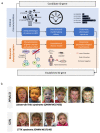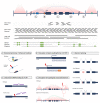The Genetics of Intellectual Disability
- PMID: 36831774
- PMCID: PMC9953898
- DOI: 10.3390/brainsci13020231
The Genetics of Intellectual Disability
Abstract
Intellectual disability (ID) has a prevalence of ~2-3% in the general population, having a large societal impact. The underlying cause of ID is largely of genetic origin; however, identifying this genetic cause has in the past often led to long diagnostic Odysseys. Over the past decades, improvements in genetic diagnostic technologies and strategies have led to these causes being more and more detectable: from cytogenetic analysis in 1959, we moved in the first decade of the 21st century from genomic microarrays with a diagnostic yield of ~20% to next-generation sequencing platforms with a yield of up to 60%. In this review, we discuss these various developments, as well as their associated challenges and implications for the field of ID, which highlight the revolutionizing shift in clinical practice from a phenotype-first into genotype-first approach.
Keywords: genetics; genotype; intellectual disability; next-generation sequencing; phenotype.
Conflict of interest statement
The authors declare no conflict of interest.
Figures








References
-
- American Psychiatric Association, DSM V. 2013. [(accessed on 1 November 2022)]. Available online: http://www.dsm5.org.
-
- Shevell M., Ashwal S., Donley D., Flint J., Gingold M., Hirtz D., Majnemer A., Noetzel M., Sheth R.D. Practice parameter: Evaluation of the child with global developmental delay: Report of the Quality Standards Subcommittee of the American Academy of Neurology and The Practice Committee of the Child Neurology Society. Neurology. 2003;60:367–380. doi: 10.1212/01.WNL.0000031431.81555.16. - DOI - PubMed
-
- Spindler U.P., Hotopp L.C., Bach V.A., Hornemann F., Syrbe S., Andreas A., Merkenschlager A., Kiess W., Bernhard M.K., Bertsche T., et al. Seizure disorders and developmental disorders: Impact on life of affected families—A structured interview. Eur. J. Pediatr. 2017;176:1121–1129. doi: 10.1007/s00431-017-2958-0. - DOI - PubMed
Publication types
LinkOut - more resources
Full Text Sources
Miscellaneous

